Michigan is famous for its rich avifauna – there are over 450 bird species there with a number of those being very active during the night!
Examples of nocturnal birds in Michigan include the barred owl, common nighthawk, American woodcock, eastern whip-poor-will, barn owl, and many others.
Do some of them sound familiar? Let’s jump in and see what each of these looks and sounds like!
Table of Contents
Nocturnal Birds In Michigan
Common Nighthawk

- Scientific Name: Chordeiles minor
- Length: 8.7-9.8 in
- Wingspan: 20-24 in
- Weight: 1.9-3.5 oz
These medium-sized birds with forked tails and long, pointed wings are crepuscular and nocturnal raptors found throughout Michigan.
Whether you live in the Upper or Lower Peninsula, you might get spot one from May to September, when they come to the state to breed.
Keep in mind that common nighthawks are camouflaged and blend well with the environment during the day. Their plumage is usually gray, black, and brown with white wing patches close to the base of primary feathers.
There are 9 recognized subspecies of common nighthawks.
They are common around prairies, forests, savannahs, and urban areas, where they feed on large insects during the night.
Source: Unknown author, Public domain, via Wikimedia Commons
During summer evenings, watch and listen for their “booming” flight displays where they fly slightly above trees before diving down for the ground. Their wingtips will make deep booms, similar to racing cars passing by.
Read More: Examples of nocturnal birds of SC
Eastern Whip-poor-will
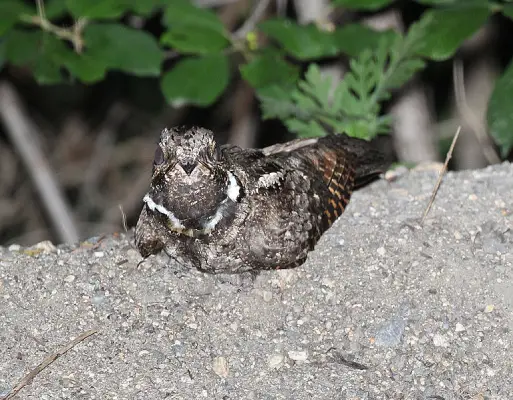
- Scientific Name: Antrostomus vociferus
- Length: 8.7-10.6 in
- Wingspan: 17.7-19.6 in
- Weight: 1.5-2.4 oz
Whip-poor-wills can be seen throughout Michigan during the breeding season.
In the state, they breed from mid-May to the start of July, and migrate south around September and October – they start returning back around the first week of May.
These cryptic nocturnal birds are easier to hear than to see as they remain motionless and sleep during the day. The best way to identify them is by their song – a whistled “whip-poor-will” that is emitted in forests with open understories they inhabit.
Source: G. McGrane, Public domain, via Wikimedia Commons
Eastern whip-poor-wills have mottled plumage with a mixture of brown, black, and gray that camouflages them well with their environment.
They hunt at night, feeding on flying insects they catch from the ground.
Eastern whip-poor-wills closely resemble common nighthawks – the two can be differentiated by their behavior and characteristic call.
Read More: What animals come out at night in Michigan?
Black-crowned Night Heron
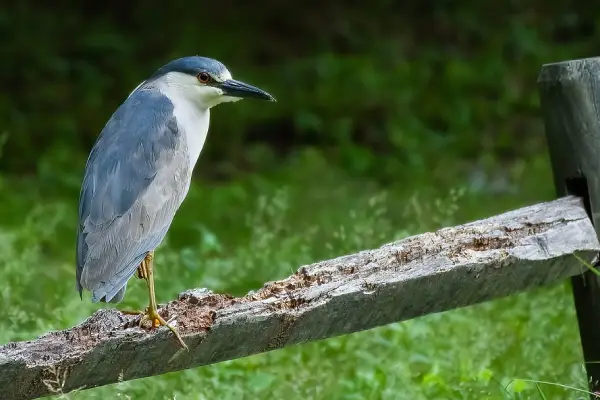
- Scientific Name: Nycticorax nycticorax
- Length: 22.8-26 in
- Wingspan: 45.3-46.5 in
- Weight: 25.6-35.8 oz
These pale grayish herons with large heads, black caps, short legs, and red eyes, often hold their short necks tucked in which gives an impression of a stocky build.
Black-crowned night herons, also known as black-capped night herons, are one of the most widespread heron species in the world.
In Michigan, they can be seen in the southern parts of the state, especially around wooded swamps, ponds, lakes, and mangroves.
Unlike most of their long-legged heron relatives, black-crowned night herons are most active at night or at dusk, when they feed on fish, frogs, small mammals, young waterbirds, insects, snakes, and even garbage at landfills.
Black-crowned night herons are one of several heron species that will bait fish – throw some food in the water to lure the fish before striking them with their long beaks. These nocturnal and noisy herons will also migrate in large flocks exclusively during the night.
Part of their scientific name “Nycticorax” comes from ancient Greek and means “night raven”, referring to their nocturnal feeding habits and croaking crow-like calls.
Source: Jonathon Jongsma, CC BY-SA 3.0, via Wikimedia Commons
Read More: What birds chirp at night in Tennessee?
Eastern Screech-owl

- Scientific Name: Megascops asio
- Length: 6.3-10 in
- Wingspan: 18-24 in
- Weight: 4-8 oz
Eastern screech owls are small and stocky owls with big heads, large yellow eyes, often-raised small ear tufts, and horn-colored beaks.
In Michigan, they are found in Lower Peninsula, around different habitats with trees and near water.
Eastern screech-owls are easier to hear than to see – they are most active at night when they hunt insects, small mammals, and birds. Their big eyes and sharp vision come in very handy for picking up small movements at night.
Source: Jonathon Jongsma, CC BY-SA 3.0, via Wikimedia Commons
Out of all North American owls, they are the most strictly nocturnal.
Eastern screech-owls come in two colors: mostly gray or mostly reddish-brown – regardless of the overall color, they are patterned with complex bands and spots that help camouflage these birds against tree bark.
These owls are also one of the most common birds found in northern parts of Georgia.
Great Horned Owl

- Scientific Name: Bubo virginianus
- Length: 17-25 in
- Wingspan: 35.8-60.2 in
- Weight: 2.7-3.5 lb
Majestic great horned owls are one of the biggest birds found in Michigan. They measure almost two feet long, weigh up to 3.5 pounds, and can be found throughout the year in the state.
They live in mountains, grasslands, conifer forests, deserts, chaparrals, and many other habitats.
Great horned owls have the most diverse diet of all North American raptors. Aggressive and excellent hunters, these big birds feed on rabbits, hares, rats, mice, voles, other small mammals, larger mid-sized mammals, reptiles, amphibians, and invertebrates.
They might occasionally even attack larger prey, including raptors such as ospreys, Peregrine falcons, prairie falcons, and other owls.
Great horned owls hunt during the night using their acute hearing and excellent eyesight and can fly in near silence to catch the prey by surprise.
In case you see a great horned owl in person, you will notice long, earlike tufts, intimidating yellow eyes, and a deep hooting call.
Source: Michael & Katie LaTour, CC BY-SA 4.0, via Wikimedia Commons
Great horned owls are monogamous birds and may stay together for over five years, sometimes even for a lifetime.
They are one of the earliest nesting birds in North America, often laying eggs weeks and months before other raptors. Typically well-camouflaged, these nocturnal owls are never easy to spot in the wild.
Interested to see what these owls would look like with blue eyes? Check this article.
Barred Owl
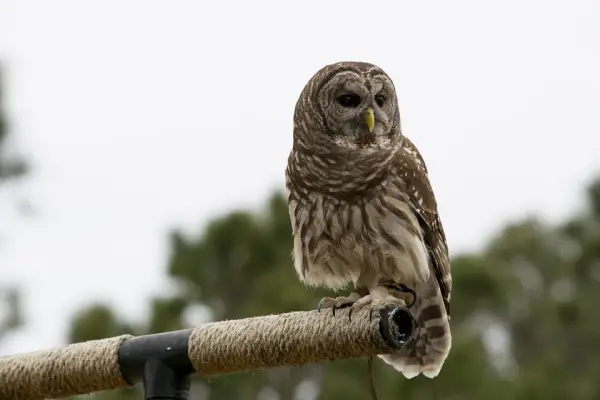
- Scientific Name: Strix varia
- Length: 16-25 in
- Wingspan: 38-49 in
- Weight: 1.3-2.5 lb
Known under several names (northern barred owls, striped owls, or more informally, hoot owls), barred owls are large birds with mottled brown and white plumage.
They can be identified by their yellow beaks, absence of ear tufts, and hoots that sound like “who cooks for you, who cooks for you all” and that can be heard almost half a mile away.
Source: Jonathon Jongsma, CC BY-SA 4.0, via Wikimedia Commons
Barred owls also have large and dark brown, almost black eyes.
Barred owls are nocturnal birds of prey that live in Michigan year-round and hunt for small prey such as insects, small mammals, crayfish, and crabs, around woods and swamps.
They are mostly active at night but might occasionally call and hunt during the day.
Barred owls will nest in tree holes or use abandoned nests of other animals, from red-tailed hawks to squirrels. After they establish nests, they become very territorial and aggressive – they will chase away intruders by hooting aggressively or attacking them with their sharp talons!
Read More: Most common night birds found in Louisiana!
Great Gray Owl
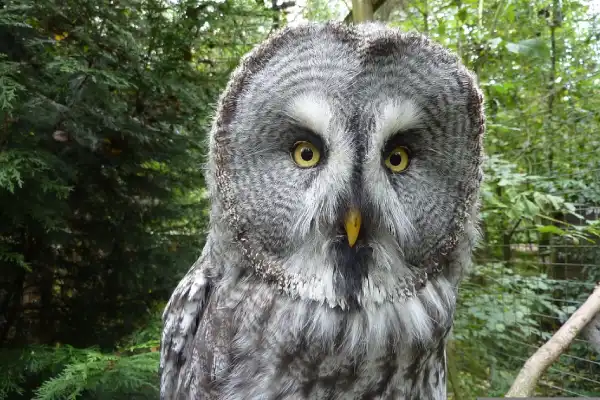
- Scientific Name: Strix nebulosa
- Length: 24-33 in
- Wingspan: 56-60 in
- Weight: 1.2-4 lb
Great gray owls are the largest species of owls in the world by length.
They are known under several names, including Phantoms of the North, bearded owls, sooty owls, etc.
Great gray owls are non-breeding residents of Michigan that mostly live in the forests along the Great Lakes in the north.
Patterned with brown and white mottling, streaks, and barrings, great gray owls blend perfectly with the gray-brown bark of their conifer perch. They also have large yellow eyes on their large round heads.
Great gray owls are a very rare species that hunt around dusk and dawn, mostly on voles. Although mostly silent, solitary, and stealthy, these raptors have been known to drive off predators as large as black bears when defending their nests.
They are the most vocal during the breeding season with males defending their territories with deep “hoos“.
Read More: List of night birds common in GA
Long-eared Owl
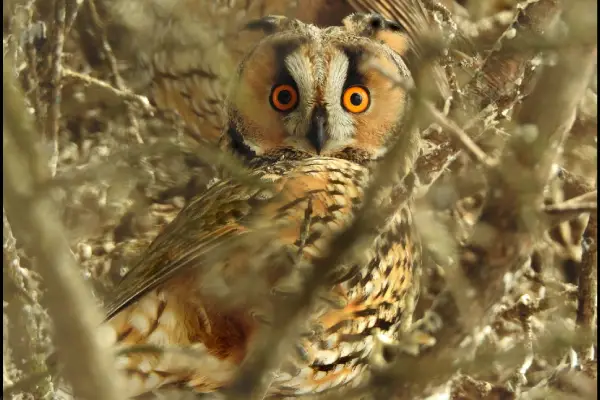
- Scientific Name: Asio otus
- Length: 12-16 in
- Wingspan: 34-40 in
- Weight: 9-15 oz
These secretive, nocturnal, and well-camouflaged owls are permanent residents of the entire Upper and northern and central parts of the Lower Peninsula.
If you live in Michigan, the best way to identify them would be to listen for their calls – males can be extremely vocal and emit hoots that can be heard from over half a mile away.
Source: Alexander Kurthy, CC BY-SA 4.0, via Wikimedia Commons
Also known as northern long-eared owls, lesser horned owls, or cat owls, these medium-sized owls with long ear tufts inhabit brushy thickets, conifer groves, and semi-open areas.
North American long-eared owls have yellow eyes, while their Eurasian counterparts have orange-reddish ones. Long-eared owls also have gray-brown bodies with pale bars and heavy streaks on their underparts.
They are specialized hunters, focusing entirely on small rodents. For example, in Japan, long-eared owls primarily consume Japanese grass voles, gray red-backed voles, and house mice.
You can also read more about the other 11 owl species found in Japan.
Short-eared Owl

- Scientific Name: Asio flammeus
- Length: 13-17 in
- Wingspan: 33-43 in
- Weight: 7.3-16.8 oz
Short-eared owls are found on all continents except Antarctica and Australia, making them one of the most widespread bird species.
In Michigan, these nocturnal owls can be seen during summer in the Upper Peninsula and northern parts of the Lower Peninsula and year-round in the southern parts of the state.
They mostly inhabit open grasslands, including weedy fields, grass strips of small airports, coastal marshes, and even agricultural fields with stubble.
Short-eared owls are mottled brown above, whitish below, and have very short ear tufts and black beaks. They also have large yellow eyes that are accentuated by black rings, making them look like they are wearing mascara!
Although mostly silent, short-eared owls will make a series of “voo-hoo-hoo” calls during the breeding season.
Source: Jamescandless, CC BY-SA 3.0, via Wikimedia Commons
They are generally nocturnal when most of the hunting happens, but they can also be crepuscular (active near dawn and dusk) and even diurnal (to a much lesser extent).
These owls are migratory birds that feed mostly on voles, rats, bats, mice, squirrels, rabbits, and some birds.
Fun Fact: Short-eared owls are fearless birds that will often harass falcons, herons, and eagles, just for fun!
Read More: List of night birds commonly heard in New York
Northern Saw-whet Owl

- Scientific Name: Aegolius acadicus
- Length: 6.7-8.7 in
- Wingspan: 16.5-22.2 in
- Weight: 1.9-5.3 oz
These small owls native to North America are often found around coniferous and deciduous forests.
In Michigan, you might spot them throughout the year. With a length of 6.7-8.7 inches and a weight of 1.9-5.3 ounces, they are one of the smallest owl species there.
Northern saw-whet owls are mottled brown with white-spotted heads, whitish facial disks, yellow eyes, and lack of ear tufts. The compound called porphyrin makes their flight feathers unique – the pigment gives their feathers a neon pink fluorescence when exposed to UV light.
Northern saw-whet owls were named after their loud and repetitive whistles described as “a saw being sharpened on a whetstone”.
Strictly nocturnal and solitary, the species hunt at night from low perch and use sight and sound to locate their prey. Northern saw-whet owls are carnivores and mostly feed on mice, voles, lemmings, small birds, and some insects.
These owls are also commonly heard during the night in Alabama.
Barn Owl
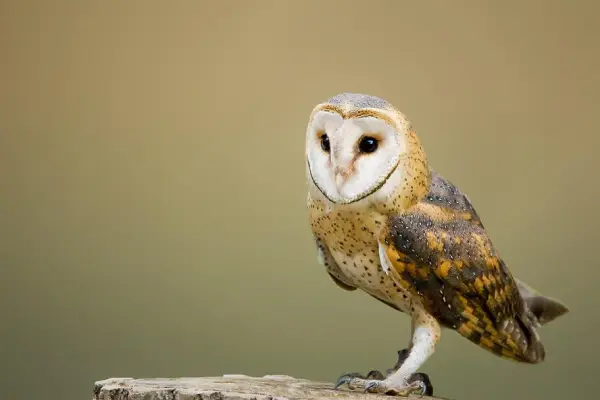
- Scientific Name: Tyto alba
- Length: 13-15 in
- Wingspan: 31-37 in
- Weight: 9-19 oz
One of the most widely distributed species of owl in the world, barn owls are highly elusive raptors found around open fields, riparian areas, and farms.
These medium-sized owls have a “ghostly” appearance due to their heart-shaped heads, cinnamon and gray upperparts, and white underparts.
Barn owls are found year-round in Lower Michigan, but due to habitat loss, they are becoming less common in the state.
Barn owls do not hoot and make bone-chilling screams instead. They hunt for rodents during the night and roost in nest boxes, caves, tree hollows, and old buildings.
Source: Luis Gracia, CC BY-SA 4.0, via Wikimedia Commons
They are quite common in the USA and can be seen in southern California, northern California, east Tennessee, west Washington, etc.
American Woodcock

- Scientific Name: Scolopax minor
- Length: 10-12 in
- Wingspan: 16.5-18.9 in
- Weight: 5-8 oz
American woodcocks are small shorebirds found throughout Michigan during summer.
They mainly inhabit brushy and young-forested habitats and are easy to spot by their large heads, short necks, and short tails. Their plumage is a mix of browns, grays, and blacks.
American woodcocks also have very long, straight, and prehensile beaks. During the night, they spend their time probing the soil in pursuit of earthworms and other invertebrates.
Thanks to the unique beak structure, woodcocks can open and close the tips of their upper bills while they are sunk into the ground.
American Woodcock also migrate at night and might hit windows, communications towers, and other structures.
Because of their nocturnal lifestyle, inconspicuous colors, and low-profile behaviors, American woodcocks are usually very hard to spot. Around dusk and dawn during springtime, you might manage to find males showing off with their stunning aerial displays.
Source: Jonathon Jongsma, CC BY-SA 3.0, via Wikimedia Commons
They are also known as timberdoodles, bogsuckers, and hokumpokes and have unique and large eyes that allow them to see 360° horizontally and 180° vertically.
American woodcocks are popular game birds, with over half a million birds caught annually by hunters.
Read More: What are some common night birds of Ohio?
Summary
Michigan’s rich avifauna is brimming with nocturnal birds. Some can be seen year-round there, like several owl species, while others, like common nighthawks, visit the state only to breed.
In case you’ve stumbled upon any of these birds, we hope this guide helped you identify which ones they were.
Feel free to read our other popular articles on birds: Nocturnal birds found in Texas and Nocturnal birds found in Florida